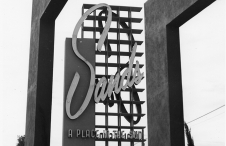Luxor Hotel
The Luxor, an Egyptian pyramid-shaped hotel opened by William Bennett's Circus Circus Enterprises in 1993, was among the first of a decade-long wave of new megaresorts to emerge on the Las Vegas Strip in the 1990s during the brief period when megaresorts flirted with catering toward adults with children.
Bennett, as the chief executive of Circus Circus, had since the mid-1970s enjoyed success with his company's Circus Circus hotel-casino, one of the first major Strip casinos to market itself specifically toward middle class customers and their children. His intent for the Luxor was to make a play for upper income patrons as well.
In 1990, only three years before the Luxor, Bennett opened the Excalibur, on Tropicana Avenue and the Strip. The Excalibur, themed after a medieval castle, was the first new megaresort following Steve Wynn's Mirage Hotel, and had a then-record 4,032 hotel rooms. In 1991, at the Excalibur, Bennett announced that a new megaresort, based on ancient Egypt, would be built next door and directly south, connected to the Excalibur by a monorail. A public contest was held to name the new place, and the winner was "Luxor," the name of an ancient Egyptian city on the east side of the Nile River.
By the early 1990s, two other megaresorts were in the planning stages—the Treasure Island, another Wynn project about a half-mile north of Excalibur, and the new MGM Grand, by Kirk Kerkorian, also at Tropicana and the Strip. At the time, many Las Vegas promoters believed that their main competitor for visitors was Orlando, Florida, the home of several popular theme parks with low-cost travel packages for families that were drawing millions of vacationers with money to spend.
The design trend for the new Las Vegas megaresorts included novel and eye-catching "Disney-like" elements to draw visitors, since it now took more than simply casino gambling, showroom entertainment, and cheap rooms and food. Wynn's Mirage had started it all, with attractions like a live, erupting faux volcano outside, a windowed white tiger habitat inside, and a dolphin habitat in the rear. However, by the mid-to-late 1990s, hotel marketers began to turn away from families and back to emphasizing adults and the convention and meeting business.
On October 13, 1993, after only eighteen months of construction, the Luxor debuted with a billed 2,526 guest rooms and suites, 120,000 square feet of casino area, a showroom, restaurants, and entertainment venues on its second floor. Its thirty-story glass and steel pyramid was three-quarters the size of its model, the Great Pyramid in Giza, Egypt.
The Luxor immediately became one of the most publicized and photographed icons of the Strip. The entrance was meant to replicate an Egyptian temple. The interior housed one of the world's largest atriums, where visitors could see the hotel room floors. The resort's apex featured a beam of light into the night sky that could be seen throughout the Las Vegas Valley and beyond. Some suites had floor-to-ceiling windows. Regular guest rooms had views through slanted windows on the sides of the pyramid.
Other additions followed soon after the opening. The resort was fronted by a 110-foot high, brightly colored Sphinx sculpture. Its sign on the Strip was a tall Egyptian temple obelisk (without neon, following Wynn's lead of no neon at the Mirage). The hotel also had a five-acre pool area and a spa. As he had with the Excalibur, Bennett kept the Luxor's opening costs down. The price tag was $375 million, considerably less than the $630 million Mirage.
But Bennett's new resort also met with controversy when it opened. Construction was not completed and some guests were booked into rooms that still needed work. The hotel's unique elevator system, dubbed "inclinators" for ascending and descending the hotel's slanted interior, was not working properly. Critics complained that the Luxor's sunken casino was less than inviting to gamblers—it was later redesigned. Even though the Luxor was considerably more upscale than the Excalibur, it did not become the significant hit among the high-roller gamblers that Bennett had hoped.
One of the resort's inaugural features was its Nile River ride, whereby passengers rode on a boat in a narrow "river" bordering the casino. The costumed leader of the river tour used a laser light to reveal details of Egyptian-style paintings along the way. But the tour, which was less than instructive, would later be cancelled, and the river's water drained in favor of more public space. Over the casino, the second floor included restaurants, a thrill ride (patrons' seats moved in sync with the images on a film) and a "virtual reality" attraction developed by Hollywood special effects expert Douglas Trumbull (2001: A Space Odyssey).
Not long after the opening, the hotel learned that part of the building was sinking into a soft spot in the usually hard desert floor and adjustments were made to halt it. In 1994, Bennett was forced to leave Circus Circus following a spat with company officials over the former site of the Hacienda Hotel, immediately south of Luxor (where the company would build the Mandalay Bay resort).
Later in the 1990s, the Luxor added a laser light show, an ice rink, and an IMAX theater for showing 3-D films. In 1997, it installed a pair of "stepped" hotel towers and a series of strobe lights on the pyramid. The hotel now had 4,408 rooms and suites. The Luxor's lobby was extensively renovated with Egyptian columns and painted murals. Other amenities included the hotel's Tomb and Museum of King Tutankhamen, giving tourists a look at a life-sized reproduction of the original tomb found in Egypt by explorers in 1922.
In 2004, a 310-foot sky bridge connected Luxor to Mandalay Place, a 100,000 square-foot shopping mall, and the Mandalay Bay resort. In April 2005, two and one-half years after Bennett's death, the Las Vegas casino company MGM Mirage bought out the Luxor's parent firm, renamed Mandalay Resort Group, for almost $8 billion.



